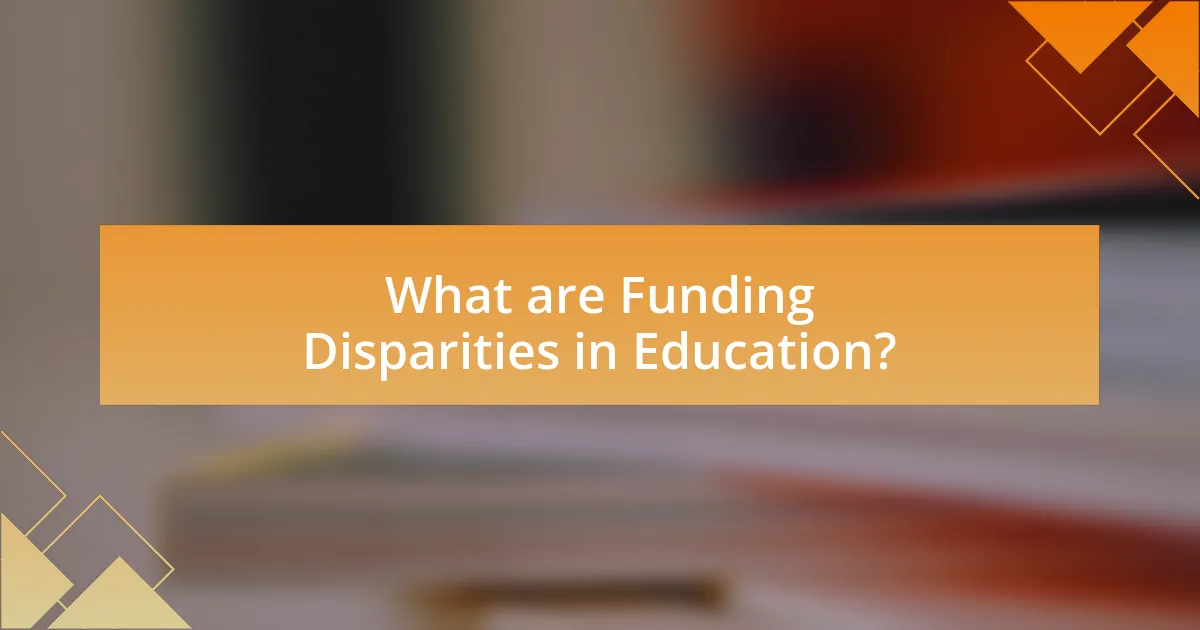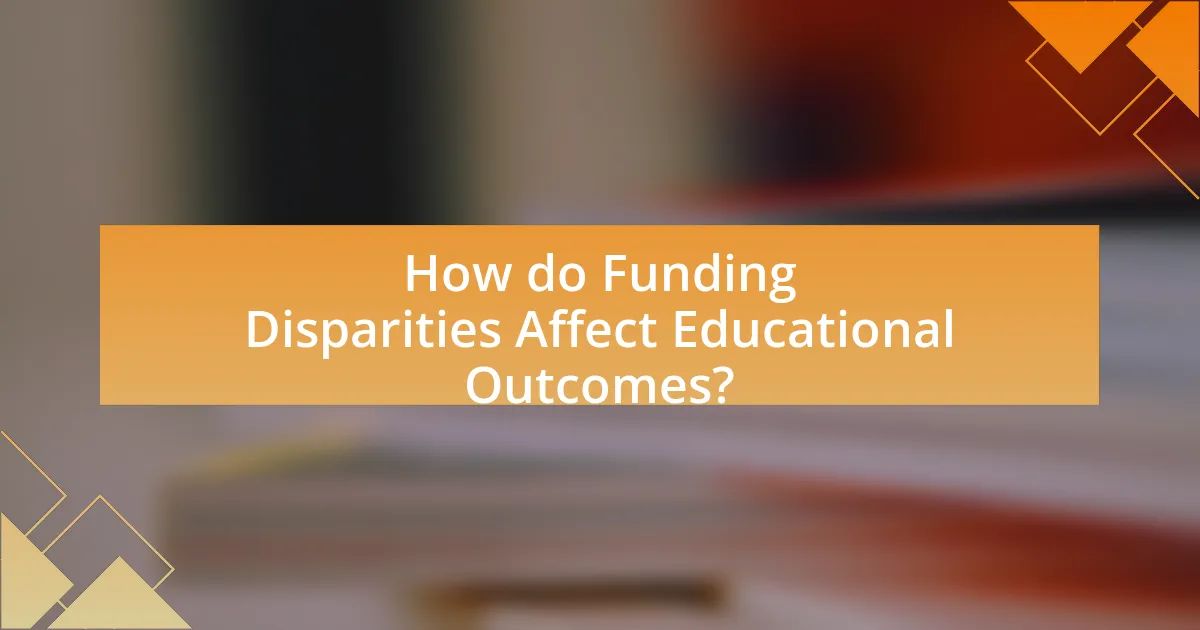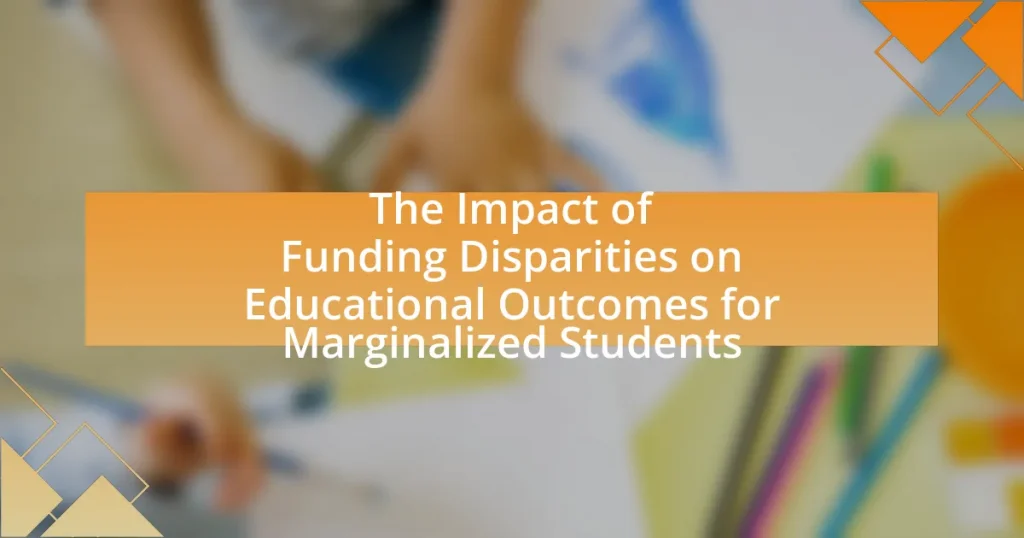Funding disparities in education refer to the unequal allocation of financial resources among schools, often influenced by local property taxes and state funding formulas. These disparities lead to significant differences in educational quality, access to advanced courses, and support services, disproportionately impacting marginalized students. The article examines how funding disparities arise, the factors contributing to unequal funding, and the influence of local, state, and federal policies on these inequities. It highlights the negative effects on educational outcomes, including lower academic performance and higher dropout rates among marginalized students, and discusses potential solutions to mitigate these disparities for improved educational equity.

What are Funding Disparities in Education?
Funding disparities in education refer to the unequal distribution of financial resources among schools, often based on local property taxes and state funding formulas. These disparities result in significant differences in educational quality, access to advanced courses, and availability of support services, disproportionately affecting marginalized students. For instance, a report by the Education Trust highlights that schools serving predominantly students of color receive $23 billion less in funding than those serving mostly white students, leading to lower educational outcomes for these marginalized groups.
How do funding disparities arise in educational systems?
Funding disparities in educational systems arise primarily from unequal distribution of resources based on local property taxes and state funding formulas. Wealthier communities generate more revenue through property taxes, leading to better-funded schools, while lower-income areas struggle with insufficient funding. For instance, a report by the Education Trust highlights that schools in high-poverty areas receive about $1,200 less per student than those in affluent neighborhoods. This systemic inequality results in significant differences in educational quality, access to advanced courses, and overall student outcomes, particularly affecting marginalized students.
What factors contribute to unequal funding across schools?
Unequal funding across schools is primarily influenced by local property taxes, state funding formulas, and socioeconomic disparities. Local property taxes serve as a significant revenue source for public schools, leading to wealthier districts receiving more funding due to higher property values. State funding formulas often favor districts with lower property wealth, but many states allocate funds based on historical spending patterns, perpetuating existing inequalities. Additionally, socioeconomic factors, such as income levels and community resources, further exacerbate funding disparities, as schools in lower-income areas typically receive less financial support. According to the U.S. Department of Education, schools in high-poverty areas receive about $1,200 less per student than those in low-poverty areas, highlighting the impact of these factors on funding inequality.
How do local, state, and federal policies influence funding disparities?
Local, state, and federal policies significantly influence funding disparities by determining the allocation of financial resources to educational institutions. Local policies often rely on property taxes, leading to unequal funding based on community wealth, while state policies can create funding formulas that either mitigate or exacerbate these disparities. For instance, states like California have implemented the Local Control Funding Formula, which aims to direct more resources to schools serving low-income students. Federal policies, such as Title I funding, aim to support disadvantaged schools but often fall short due to inconsistent funding levels and bureaucratic challenges. These layered policies create a complex landscape where marginalized students frequently receive less funding, impacting their educational outcomes.
Why are funding disparities significant for marginalized students?
Funding disparities are significant for marginalized students because they directly affect the quality of education and resources available to them. When schools in low-income areas receive less funding, they often lack essential resources such as qualified teachers, advanced coursework, and extracurricular programs. For instance, a report by the U.S. Department of Education found that schools serving predominantly students of color receive about $23 billion less in funding than schools serving predominantly white students. This inequity leads to lower academic performance, reduced graduation rates, and limited opportunities for marginalized students, perpetuating cycles of poverty and disadvantage.
What impact do funding disparities have on educational resources available to marginalized students?
Funding disparities significantly limit the educational resources available to marginalized students. Schools in low-income areas often receive less funding due to reliance on local property taxes, resulting in inadequate facilities, outdated materials, and fewer extracurricular programs. For instance, a report by the Education Trust highlights that schools serving predominantly students of color receive about $23 billion less in funding than those serving mostly white students. This inequity leads to larger class sizes, reduced access to advanced coursework, and fewer qualified teachers, ultimately hindering the academic achievement and future opportunities for marginalized students.
How do funding disparities affect teacher quality and retention in marginalized communities?
Funding disparities significantly diminish teacher quality and retention in marginalized communities. Schools in these areas often receive less financial support, leading to inadequate resources, lower salaries, and limited professional development opportunities for teachers. Research from the National Center for Education Statistics indicates that schools serving low-income students typically have higher teacher turnover rates, which disrupts student learning and negatively impacts educational outcomes. Furthermore, a study by the Learning Policy Institute found that teachers in underfunded schools are more likely to leave the profession due to lack of support and resources, exacerbating the challenges faced by students in marginalized communities.

How do Funding Disparities Affect Educational Outcomes?
Funding disparities negatively affect educational outcomes by creating unequal access to resources, which leads to significant differences in student achievement. Schools in low-income areas often receive less funding, resulting in larger class sizes, outdated materials, and fewer extracurricular opportunities. For instance, a study by the National Center for Education Statistics found that schools serving predominantly low-income students receive about $1,000 less per pupil than those serving wealthier populations. This lack of funding contributes to lower graduation rates and diminished college readiness among marginalized students, as evidenced by data showing that students from underfunded schools score lower on standardized tests compared to their peers in better-funded institutions.
What are the measurable educational outcomes impacted by funding disparities?
Funding disparities significantly impact measurable educational outcomes such as student achievement, graduation rates, and access to advanced coursework. Research indicates that schools in lower-income areas often receive less funding, leading to larger class sizes, fewer resources, and diminished educational opportunities. For instance, a study by the National Center for Education Statistics found that students in high-poverty schools scored, on average, 20% lower on standardized tests compared to their peers in affluent districts. Additionally, graduation rates are consistently lower in underfunded schools; the U.S. Department of Education reported that schools with high levels of funding disparity had graduation rates that were 10% lower than those with equitable funding. Access to advanced placement courses is also limited in these schools, with only 30% of students in low-income areas having the opportunity to enroll in such programs, compared to 70% in wealthier districts. These statistics illustrate the direct correlation between funding levels and educational outcomes for marginalized students.
How do funding disparities influence student achievement and test scores?
Funding disparities significantly influence student achievement and test scores by creating unequal access to educational resources. Schools in wealthier areas often receive more funding, allowing them to provide better facilities, advanced technology, and experienced teachers, which directly correlates with higher student performance. For instance, a study by the National Center for Education Statistics found that schools with higher funding levels had students who scored, on average, 20% higher on standardized tests compared to those in underfunded schools. This disparity in funding leads to a cycle where students in lower-funded schools face challenges that hinder their academic success, perpetuating educational inequities.
What role does funding play in dropout rates among marginalized students?
Funding significantly influences dropout rates among marginalized students by directly affecting the quality of educational resources and support services available to them. Schools with inadequate funding often struggle to provide essential programs, experienced teachers, and necessary materials, leading to lower student engagement and higher dropout rates. For instance, a study by the U.S. Department of Education found that schools serving predominantly low-income students receive about $1,000 less per pupil than those serving wealthier populations, which correlates with increased dropout rates in marginalized communities. This disparity in funding creates an environment where marginalized students are less likely to succeed academically, ultimately contributing to higher dropout rates.
Why is it important to address funding disparities for equitable education?
Addressing funding disparities is crucial for equitable education because it directly influences the quality of educational resources and opportunities available to students. When funding is uneven, schools in lower-income areas often lack essential materials, experienced teachers, and advanced programs, leading to significant gaps in student achievement. Research from the National Center for Education Statistics shows that schools serving predominantly low-income students receive about $1,000 less per pupil than those serving wealthier populations. This financial inequity perpetuates cycles of disadvantage, limiting access to quality education and hindering the potential for upward mobility among marginalized students.
How can addressing funding disparities lead to improved educational equity?
Addressing funding disparities can lead to improved educational equity by ensuring that all students, regardless of their socioeconomic background, have access to the same quality of educational resources and opportunities. When funding is allocated more equitably, schools in underfunded areas can enhance their facilities, hire qualified teachers, and provide essential programs that support student learning. Research indicates that equitable funding can reduce achievement gaps; for instance, a study by the National Bureau of Economic Research found that increased funding in low-income districts significantly improved student performance on standardized tests. This demonstrates that addressing funding disparities directly contributes to leveling the educational playing field for marginalized students.
What are the long-term societal impacts of failing to address funding disparities?
Failing to address funding disparities leads to significant long-term societal impacts, including perpetuated inequality, reduced economic mobility, and diminished social cohesion. When educational institutions in marginalized communities receive inadequate funding, students often experience lower quality education, which correlates with decreased academic achievement and limited career opportunities. For instance, a study by the National Center for Education Statistics found that schools in low-income areas receive about $1,000 less per student than those in affluent areas, resulting in fewer resources, less experienced teachers, and inadequate facilities. This educational gap contributes to a cycle of poverty, as individuals from underfunded schools are less likely to attain higher education and secure well-paying jobs, ultimately affecting the overall economic health of society. Furthermore, the lack of equitable funding fosters social divisions, as disparities in education can lead to increased crime rates and social unrest, undermining community stability and cohesion.

What Solutions Exist to Mitigate Funding Disparities?
Solutions to mitigate funding disparities include equitable funding formulas, targeted grants, and community partnerships. Equitable funding formulas adjust allocations based on student needs, ensuring that schools serving marginalized populations receive adequate resources. Targeted grants, such as those from federal programs like Title I, provide additional financial support to schools with high percentages of low-income students. Community partnerships leverage local resources and expertise to enhance educational opportunities, fostering collaboration between schools and local organizations. These strategies collectively aim to address the systemic inequities in educational funding, ultimately improving outcomes for marginalized students.
How can policymakers effectively address funding disparities in education?
Policymakers can effectively address funding disparities in education by implementing equitable funding formulas that allocate resources based on student needs rather than local property taxes. Research indicates that states with weighted funding formulas, which consider factors such as poverty and English language proficiency, have seen improved educational outcomes for marginalized students. For example, the Education Trust found that states like Massachusetts and New Jersey, which utilize such formulas, have made significant strides in closing achievement gaps. Additionally, increasing state and federal investment in underfunded districts can help ensure that all students have access to quality education, thereby reducing disparities.
What legislative measures have been proposed to equalize funding?
Legislative measures proposed to equalize funding include the introduction of bills aimed at revising state funding formulas to ensure equitable distribution of resources among schools, particularly those serving marginalized communities. For instance, the Every Student Succeeds Act (ESSA) encourages states to allocate funds based on student needs, promoting equity in educational opportunities. Additionally, various states have proposed legislation to increase funding for Title I schools, which serve low-income students, thereby addressing funding disparities directly. These measures are supported by research indicating that equitable funding leads to improved educational outcomes for marginalized students, as evidenced by studies showing that increased funding correlates with higher student achievement in underfunded districts.
How can community engagement play a role in addressing funding disparities?
Community engagement can significantly address funding disparities by fostering collaboration between local stakeholders and educational institutions. Engaged communities can advocate for equitable funding, ensuring that the needs of marginalized students are prioritized. For instance, research from the National Education Association indicates that community involvement in school decision-making leads to increased funding allocations and resource distribution, particularly in underfunded areas. This collaborative approach not only raises awareness about funding inequities but also mobilizes resources and support from various sectors, ultimately enhancing educational outcomes for marginalized students.
What best practices can schools implement to maximize available funding?
Schools can maximize available funding by implementing strategic budgeting practices, actively pursuing grants, and fostering community partnerships. Strategic budgeting involves prioritizing essential programs and reallocating resources to areas with the greatest need, which can enhance educational outcomes for marginalized students. Actively pursuing grants from federal, state, and private sources can provide additional financial support; for instance, the U.S. Department of Education offers various grant programs aimed at improving educational equity. Furthermore, fostering community partnerships with local businesses and organizations can lead to resource sharing and financial contributions, thereby increasing funding opportunities. These practices are supported by research indicating that schools that engage in comprehensive funding strategies see improved educational outcomes, particularly for underserved populations.
How can schools leverage partnerships to enhance educational resources?
Schools can leverage partnerships with local businesses, non-profits, and community organizations to enhance educational resources. By collaborating with these entities, schools can access additional funding, materials, and expertise that may not be available through traditional funding sources. For instance, partnerships with local businesses can provide financial support for programs, while non-profits can offer specialized services or resources tailored to the needs of marginalized students. Research indicates that schools with strong community partnerships often see improved educational outcomes, as these collaborations can lead to increased student engagement and access to diverse learning opportunities.
What strategies can schools adopt to improve educational outcomes despite funding challenges?
Schools can adopt strategies such as implementing community partnerships, leveraging technology, and focusing on teacher training to improve educational outcomes despite funding challenges. Community partnerships can provide additional resources and support, as evidenced by programs like the Harlem Children’s Zone, which has shown significant improvements in student performance through collaboration with local organizations. Leveraging technology, such as online learning platforms, can enhance access to educational materials and personalized learning experiences, as demonstrated by the success of blended learning models in various districts. Additionally, investing in teacher training ensures that educators are equipped with effective instructional strategies, which is crucial since research indicates that teacher quality is a primary factor in student achievement. These strategies collectively help mitigate the impact of funding disparities on marginalized students.
What are practical steps for advocating for equitable funding in education?
To advocate for equitable funding in education, individuals and organizations should engage in grassroots mobilization, policy advocacy, and coalition building. Grassroots mobilization involves organizing community members to raise awareness about funding disparities and their impact on marginalized students, which can lead to increased public pressure on decision-makers. Policy advocacy includes lobbying local, state, and federal legislators to support equitable funding initiatives, such as the Fair Funding Formula, which aims to allocate resources based on student needs rather than property taxes. Coalition building with other stakeholders, including parents, educators, and community organizations, strengthens the advocacy efforts by creating a unified voice that highlights the urgency of addressing funding inequities. These steps are supported by research indicating that equitable funding significantly improves educational outcomes for marginalized students, as evidenced by studies showing that increased funding correlates with higher graduation rates and improved academic performance.



